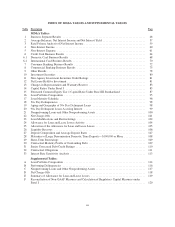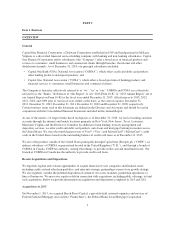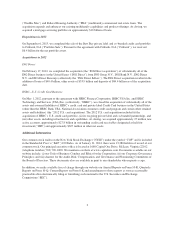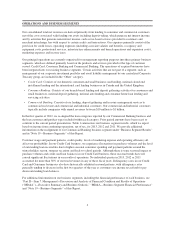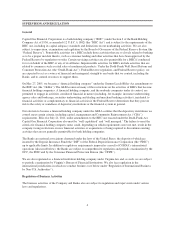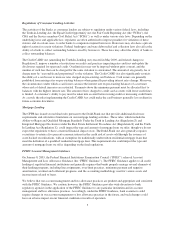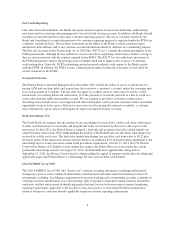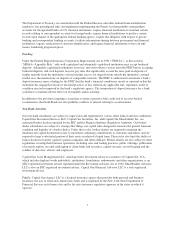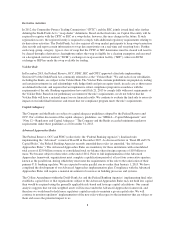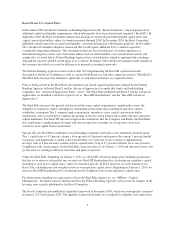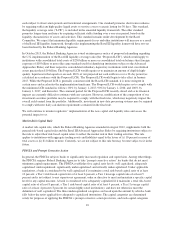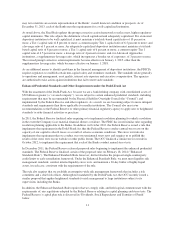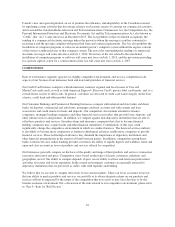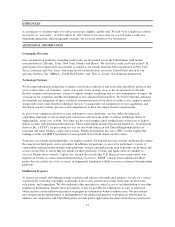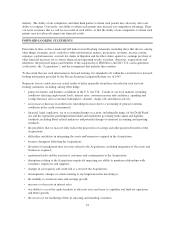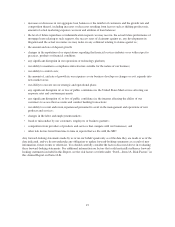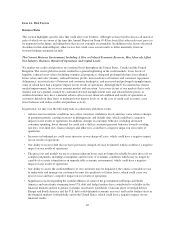Capital One 2013 Annual Report Download - page 30
Download and view the complete annual report
Please find page 30 of the 2013 Capital One annual report below. You can navigate through the pages in the report by either clicking on the pages listed below, or by using the keyword search tool below to find specific information within the annual report.each subject to observation periods and transitional arrangements. One standard promotes short-term resilience
by requiring sufficient high-quality liquid assets to survive a stress scenario lasting for 30 days. This standard,
the liquidity coverage ratio (“LCR”), is included in the amended liquidity framework. The other standard
promotes longer-term resilience by requiring sufficient stable funding over a one-year period, based on the
liquidity characteristics of assets and activities. This standard remains under development by the Basel
Committee. We expect that minimum liquidity requirements for us and other institutions will increase as a result
of the Basel III liquidity framework, though rules implementing the Basel III liquidity framework have not yet
been finalized by the Federal Banking Agencies.
In October 2013, the Federal Banking Agencies issued an interagency notice of proposed rulemaking regarding
the U.S. implementation of the Basel III liquidity coverage ratio (the “Proposed LCR”), which would apply to
institutions with consolidated total assets of $250 billion or more or consolidated total on balance sheet foreign
exposure of $10 billion or more (the same standard used for identifying institutions subject to the Advanced
Approaches Rules) and their respective consolidated subsidiary depository institutions with total consolidated
assets greater than $10 billion. The Proposed LCR would require us to maintain an amount of eligible high-
quality, liquid assets that equals or exceeds 100% of our projected net cash outflows over a 30-day period (as
calculated in accordance with the Proposed LCR). The Proposed LCR would begin to take effect in January
2015. While the Proposed LCR is generally consistent with the Basel LCR standard, it is more stringent in
certain areas and accelerates the implementation timeframe. The Proposed LCR would require us to comply with
the minimum LCR standard as follows: 80% by January 1, 2015; 90% by January 1, 2016; and 100% by
January 1, 2017, and thereafter. The comment period for the Proposed LCR recently closed and so its financial
impacts are currently difficult to estimate with any certainty. However, modification of the composition of our
investment securities portfolio may be required to comply with the final rules, which may negatively impact the
overall yield earned from the portfolio. Additionally, investment in new data processing systems may be required
to comply with new daily calculation requirements contained in the final rule.
We will continue to monitor regulators” implementation of the new capital and liquidity rules and assess the
potential impact to us.
Market Risk Capital Rule
A market risk capital rule, which the Federal Banking Agencies amended in August 2012, supplements both the
general risk-based capital rules and the Basel III Advanced Approaches Rules by requiring institutions subject to
the rule to adjust their risk-based capital ratios to reflect the market risk in their trading activities. The rule
applies to institutions with aggregate trading assets and liabilities equal to the lesser of (i) 10 percent or more of
total assets or (ii) $1 billion or more. Currently, we are not subject to this rule but may become subject to it in the
future.
FDICIA and Prompt Corrective Action
In general, the FDICIA subjects banks to significantly increased regulation and supervision. Among other things,
the FDICIA requires Federal Banking Agencies to take “prompt corrective action” for banks that do not meet
minimum capital requirements. The FDICIA establishes five capital ratio levels: well capitalized; adequately
capitalized; undercapitalized; significantly undercapitalized; and critically undercapitalized. Under applicable
regulations, a bank is considered to be well capitalized if it maintains a total risk-based capital ratio of at least
10 percent, a Tier 1 risk-based capital ratio of at least 6 percent, a Tier 1 leverage capital ratio of at least 5
percent and is not subject to any supervisory agreement, order or directive to meet and maintain a specific capital
level for any capital measure. A bank is considered to be adequately capitalized if it maintains a total risk-based
capital ratio of at least 8 percent, a Tier 1 risk-based capital ratio of at least 4 percent, a Tier 1 leverage capital
ratio of at least 4 percent (3 percent for certain highly rated institutions), and does not otherwise meet the
definition of well capitalized. The three undercapitalized categories are based upon the amount by which a bank
falls below the ratios applicable to adequately-capitalized institutions. The capital categories are determined
solely for purposes of applying the FDICIA’s prompt corrective action provisions, and such capital categories
10


